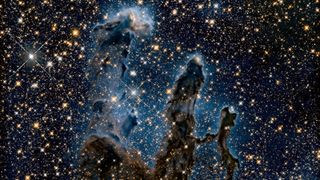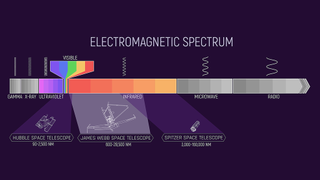How the James Webb Space Telescope's infrared detectors will open new vistas in astronomy
The telescope 'time machine' will deliver 13.5 billion years of cosmic history.

The newest deep space observatory, the James Webb Space Telescope, will give us a deeper view into the infrared universe than the iconic Hubble.
A new video from the European Space Agency (ESA) showcases how Webb will open new vistas into astronomical objects across the universe, ranging from galaxies formed billions of years ago to clouds of gas and dust surrounding newborn stars.
Infrared light is the heat-carrying part of the electromagnetic spectrum with longer wavelengths than visible light. The Hubble Space Telescope is optimized for visible light but can also detect some ultraviolet (shorter wavelengths than visible) and some infrared. Webb, however, was developed as an infrared specialist and can take on a much larger span of infrared wavelengths. That, for example, means seeing even deeper into the universe than Hubble does.
Since the universe is expanding, the galaxies farther away from us are moving away at greater speeds than the closer ones. The light these galaxies emit is shifted into longer, redder, wavelengths, as a result of the Doppler effect (the same effect that distorts the sound of a passing ambulance), also known as redshift in astronomy.
Live updates: NASA's James Webb Space Telescope mission
Related: How the James Webb Space Telescope works in pictures
With better views of the early universe, NASA said in a separate release last year about Webb's infrared capabilities, astronomers hope to gain more insight about how galaxies formed and evolved.
As infrared light is less subject to interference from dust, Webb will also enable astronomers to see what's going on inside of dust clouds in the nearer universe. "We can penetrate the dust and see the processes leading to star and planet formation," ESA said in a statement.
Get the Space.com Newsletter
Breaking space news, the latest updates on rocket launches, skywatching events and more!
This means that, for example, Hubble's 2020 view of the iconic Eagle Nebula "Pillars of Creation" in infrared could look different with Webb's infrared gaze. The Pillars are a famous zone of star formation, for which Webb may provide more insight.
"Star formation in the local universe takes place in the centers of dense, dusty clouds, obscured from our eyes at normal visible wavelengths," ESA said in the statement.

Peering into objects in the nearer universe will provide additional answers that will further help astronomers build up their understanding of the universe's evolution.
"We really need to understand the local universe in order to understand all of the universe,” Martha Boyer, deputy branch manager of Webb's near-infrared camera (NIRCam), one of the two cameras on board of Webb that will perform the infrared observations, said in the NASA release.
Speaking of the galaxies closest to our own, the Milky Way, Boyer said the so-called 'Local Group' will be a mini-laboratory allowing astronomers to look at galaxies in high definition.
The Local Group consists of three main galaxies, the Milky Way included, which are all located within 5 million light-years from Earth, according to EarthSky. The largest of these galaxies is Andromeda, the Milky Way is the middle one, and a galaxy known as Triangulum is the smallest of the three. The group also includes about 50 dwarf galaxies that mostly orbit the large ones.
Further-away galaxies, Boyer added, "can’t resolve much detail, so we don’t know exactly what’s going on. A major step towards understanding distant or early galaxies is to study this collection of galaxies that are within our reach."
Follow Elizabeth Howell on Twitter @howellspace. Follow us on Twitter @Spacedotcom and on Facebook.
Join our Space Forums to keep talking space on the latest missions, night sky and more! And if you have a news tip, correction or comment, let us know at: community@space.com.

Elizabeth Howell (she/her), Ph.D., is a staff writer in the spaceflight channel since 2022 covering diversity, education and gaming as well. She was contributing writer for Space.com for 10 years before joining full-time. Elizabeth's reporting includes multiple exclusives with the White House and Office of the Vice-President of the United States, an exclusive conversation with aspiring space tourist (and NSYNC bassist) Lance Bass, speaking several times with the International Space Station, witnessing five human spaceflight launches on two continents, flying parabolic, working inside a spacesuit, and participating in a simulated Mars mission. Her latest book, "Why Am I Taller?", is co-written with astronaut Dave Williams. Elizabeth holds a Ph.D. and M.Sc. in Space Studies from the University of North Dakota, a Bachelor of Journalism from Canada's Carleton University and a Bachelor of History from Canada's Athabasca University. Elizabeth is also a post-secondary instructor in communications and science at several institutions since 2015; her experience includes developing and teaching an astronomy course at Canada's Algonquin College (with Indigenous content as well) to more than 1,000 students since 2020. Elizabeth first got interested in space after watching the movie Apollo 13 in 1996, and still wants to be an astronaut someday. Mastodon: https://qoto.org/@howellspace
